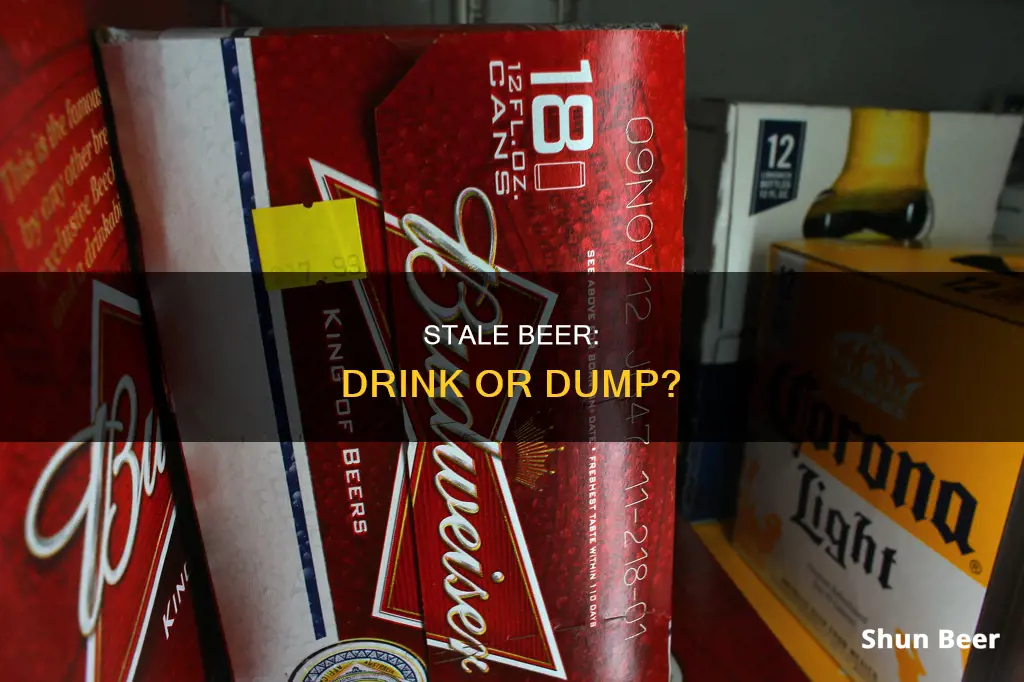
Beer is a lot like any other food or drink: it has an expiry date and it will go off. But does that mean it's unsafe to drink?
Most sources agree that drinking beer past its expiry date is harmless, and won't make you sick. The main issue with drinking expired beer is that it won't taste very nice. It's likely to be flat, smell odd, and have an unpleasant taste.
However, there are a couple of situations where you should throw out an old beer. If it's lost its fizz, that's a sign that the seal has been broken and the flavour won't be the same. And if the beer has a vinegary taste, that's a sign that bacteria has gotten in, and it should be discarded.
| Characteristics | Values |
|---|---|
| Safe to drink | Yes, but may cause a mild upset stomach |
| Taste | Unpleasant, stale, flat, bitter, overly sweet, vinegary, like wet cardboard, or stronger |
| Smell | Odd |
| Fizziness | Lost |
| Bacterial build-up | Possible |
| Expiry date | A guideline, not a rule |
| Storage | In a cool, dark place, away from sunlight, and upright |
What You'll Learn
- Drinking out-of-date beer is generally safe, but it might not taste good
- Beer has a 'best before' date, which is a guideline on quality rather than safety
- Beer is produced using a fermentation process that makes it an unfriendly environment for microorganisms
- Beer should be stored in a cool, dark place, away from direct sunlight
- Opened beer has a shelf life of about a day

Drinking out-of-date beer is generally safe, but it might not taste good
Beer does expire, but it's not the same as other foods and drinks. Beer typically has a 'best before' date, which is more of a guideline on quality than a safety warning. Drinking out-of-date beer is generally safe, but it might not taste good.
Beer is similar to wine in that it ages even after bottling. Unlike wine, however, after a certain amount of time passes, the taste gets worse rather than better. The Washington Post notes that this decrease in taste is usually caused by three factors: hops, light, and oxygen.
The fermentation process used in brewing beer, as well as its low pH level and alcohol content, make it an unfriendly environment for microorganisms. Even if a beer sits on the shelf for years, as long as it’s sealed, it’s unlikely to make you sick.
However, over time, the taste of beer changes. The beer will oxidise, and this causes the beer to stale, producing tones of sherry, paper, or cardboard. Hop aromas are muted, and hop beta acids oxidise to produce an unrefined bitterness.
There are a few ways to tell if a beer has gone bad. Firstly, if there’s an absence of the signature hissing sound when you open it, it means the beer has lost its carbonation. Secondly, if you don’t see white foam rising to the top and spilling over when you open it, it has likely gone flat. You can also check the bottle for dust, which is a good indication that the beer has been sitting on the shelf for a while.
To prolong the shelf life of your beer, store it in a dark place, out of direct sunlight, and upright at the right temperature.
Mixing Robitussin and Beer: Is it Safe?
You may want to see also

Beer has a 'best before' date, which is a guideline on quality rather than safety
Beer does have a shelf life and will expire, but this doesn't mean it becomes unsafe to drink. The fermentation process used in brewing, as well as its low pH level and alcohol content, make beer an unfriendly environment for bacteria. Even if a beer sits on the shelf for years, as long as it’s sealed, it’s unlikely to make you sick.
Beer bottles and cans will usually have a 'best before' date, which is different from a 'use by' date. 'Use by' is a rule, and after the stated date, the product will quickly degrade and may be unsafe to consume. 'Best before', on the other hand, is a guideline on quality rather than safety. The beer will start to lose its quality and won't taste as good, but it can still be consumed.
The average shelf life of beer is around six months, but it can vary depending on the type of beer and how it's packaged and stored. For example, a typical lager will be drinkable 6-24 months after its best-before date if kept in the fridge, and 9 months if it hasn't been refrigerated. Stronger beers with higher ABV, such as stouts and barley wines, can taste better with age and can be left on the shelf for a few years.
Opened beer will have a much shorter lifespan, lasting only about a day before the oxidation process destroys the good flavours.
There are a few ways to tell if your beer has gone bad. Firstly, check if there's an absence of the signature hissing sound when you open it, indicating that the beer has lost its carbonation. Fresh beer will also usually have white foam rising to the top when opened. If the beer is missing this, it has likely gone flat. You can also check the bottom of the bottle for excessive sediment, which could contribute to a poor taste.
Beer is susceptible to light exposure, oxygen exposure, and bacteria exposure, which can cause it to go bad. Exposure to ultraviolet (UV) rays can cause the hop-derived compounds in the beer to break down and combine with a sulphuric compound, resulting in a skunky odour and taste. Oxidation can also cause the beer to develop a papery or cardboard-like taste. Bacterial infections in beer are rare, but if they occur, the beer will need to be discarded.
To store beer correctly, it should be kept in a cool, dark place, preferably in the refrigerator. If storing at room temperature, ensure the beer is kept away from direct sunlight. It's also best to store beer upright to minimise the surface area exposed to oxidation.
One Beer, No Buzz: Factors Affecting Alcohol Absorption
You may want to see also

Beer is produced using a fermentation process that makes it an unfriendly environment for microorganisms
The process of making beer is called brewing. It includes breaking the starch in grains into a sugary liquid, called wort, and fermenting the sugars in the wort into alcohol and carbon dioxide by yeasts. The two main yeast species used in the fermentation process are Saccharomyces cerevisiae (top-fermenting, since it forms foam on top of the wort) and Saccharomyces uvarum (bottom-fermenting). Top-fermenting yeasts are used to produce ale, while bottom-fermenting yeasts are used to produce lagers.
Brewer’s yeasts are very rich in essential minerals and B vitamins, with the exception of vitamin B12. Beer brewing in modern days is performed by adding pure cultures of the desired yeast species to the wort. Additional yeast species that are used in making beer are Dekkera/Brettanomyces. After the fermentation is finished, the beer is cleared of the yeasts by precipitation or with the use of clearing additives.
Flooded Beer Font: How Does It Work?
You may want to see also

Beer should be stored in a cool, dark place, away from direct sunlight
Beer is sensitive to changes in temperature, UV light, and oxygen levels. To keep it tasting its best, it should be stored in a cool, dark place, away from direct sunlight.
UV rays from the sun can cause beer to develop a skunky odour and taste. This is caused by a chemical reaction between the UV light and the essential oils found in hops. The longer the beer is exposed to sunlight, the worse the effects will be. Clear or green glass bottles offer little to no protection against UV rays, whereas brown glass bottles filter out more UV light, and aluminium cans completely block it.
Oxygen can also affect the taste of beer, causing it to oxidise and develop a papery taste. Storing beer upright can help to minimise oxidation by reducing its exposure to oxygen.
Heat speeds up the oxidation process, so it's important to keep beer stored at a cool, consistent temperature. In general, beer will last 3 days at 90°F, 30 days at 72°F, and up to 300 days at 38°F.
Japanese Beer Cups: The Science Behind the Froth
You may want to see also

Opened beer has a shelf life of about a day
Beer is just like any other food: it has a shelf life and will eventually go bad. Opened beer has a shelf life of about a day, regardless of the expiration date listed. This is because, once opened, the beer will go flat as it loses its carbonation. Even if you refrigerate it, the beer will go flat as soon as you break the airtight seal.
The good news is that drinking expired beer is harmless. Beer is similar to wine in that it ages even after bottling, but unlike wine, the taste gets worse rather than better over time. The only problem is that it might not taste so good, and it's likely to smell odd and taste stale or flat.
The decrease in taste usually comes down to three factors: hops, light, and oxygen. Hops are especially sensitive to light and can become "light struck", a chemical reaction that gives off an unpleasant skunky taste. Oxygen, meanwhile, interacts with the compounds from malt, yeast, and hops, causing oxidation and a disappointing papery taste.
To prolong the shelf life of your beer, store it in a cool, dark place, away from temperature fluctuations. Keep it upright to minimize oxidation, and avoid exposing it to direct sunlight.
Beer and Smirnoff: A Match Made in Heaven?
You may want to see also
Frequently asked questions
Drinking expired beer is generally harmless. The fermentation process used in brewing, as well as its low pH level and alcohol content, make beer an unfriendly environment for bacteria. However, drinking expired beer could result in a mild upset stomach.
If your beer has lost its carbonation, it has likely expired. You may notice a lack of foam when you open the bottle or can, or an absence of the signature hissing sound. The beer may also taste flat, stale, or bitter.
Beer typically has a shelf life of 5-9 months beyond the expiration date listed on the label if stored at room temperature. In a refrigerator, unopened beer can last up to 2-3 years.







